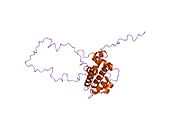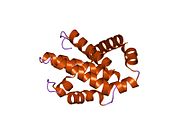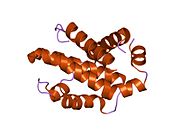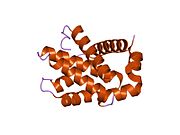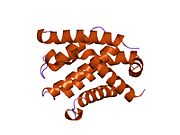Biology:Bcl-2-like protein 1
 Generic protein structure example |
Bcl-2-like protein 1 is a protein encoded in humans by the BCL2L1 gene. Through alternative splicing, the gene encodes both of the human proteins Bcl-xL and Bcl-xS.[1]
Function
The protein encoded by this gene belongs to the Bcl-2 protein family. Bcl-2 family members form hetero- or homodimers and act as anti- or pro-apoptotic regulators that are involved in a wide variety of cellular activities. The proteins encoded by this gene are located at the outer mitochondrial membrane, and have been shown to regulate outer mitochondrial membrane channel (voltage-dependent anion channels (VDACs) opening. VDACs regulate mitochondrial membrane potential, and thus controls the production of reactive oxygen species and release of cytochrome C by mitochondria, both of which are the potent inducers of cell apoptosis. Two alternatively spliced transcript variants, which encode distinct isoforms, have been reported. The longer isoform (Bcl-xL) acts as an apoptotic inhibitor and the shorter form (Bcl-xS) acts as an apoptotic activator.[1][2]
Interactions
BCL2-like 1 (gene) has been shown to interact with:
- APAF1,[3][4]
- BAK1,[5][6][7][8][9]
- BCAP31,[10]
- BCL2L11,[7][11][12][13]
- BNIP3,[14]
- BNIPL,[15][16]
- BAD,[6][11][17][18][19][20][21][22][23][24][25]
- BAX,[6][18][26][27]
- BIK,[5][11][27][28]
- Bcl-2,[6][29]
- HRK,[7][30][31]
- IKZF3,[32]
- Noxa,[11][33]
- PPP1CA,[19]
- PSEN2[34]
- RAD9A,[5][17]
- RTN1,[35]
- RTN4,[35] and
- VDAC1.[36][37][38][39]
References
- ↑ 1.0 1.1 "bcl-x, a bcl-2-related gene that functions as a dominant regulator of apoptotic cell death". Cell 74 (4): 597–608. Aug 1993. doi:10.1016/0092-8674(93)90508-N. PMID 8358789. https://deepblue.lib.umich.edu/bitstream/2027.42/30629/1/0000270.pdf.
- ↑ "Entrez Gene: BCL2L1 BCL2-like 1". https://www.ncbi.nlm.nih.gov/sites/entrez?Db=gene&Cmd=ShowDetailView&TermToSearch=598.
- ↑ "Bcl-XL interacts with Apaf-1 and inhibits Apaf-1-dependent caspase-9 activation". Proceedings of the National Academy of Sciences of the United States of America 95 (8): 4386–91. Apr 1998. doi:10.1073/pnas.95.8.4386. PMID 9539746. Bibcode: 1998PNAS...95.4386H.
- ↑ "Caspase-9, Bcl-XL, and Apaf-1 form a ternary complex". The Journal of Biological Chemistry 273 (10): 5841–5. Mar 1998. doi:10.1074/jbc.273.10.5841. PMID 9488720.
- ↑ 5.0 5.1 5.2 "Towards a proteome-scale map of the human protein-protein interaction network". Nature 437 (7062): 1173–8. Oct 2005. doi:10.1038/nature04209. PMID 16189514. Bibcode: 2005Natur.437.1173R.
- ↑ 6.0 6.1 6.2 6.3 "Development of a high-throughput fluorescence polarization assay for Bcl-x(L)". Analytical Biochemistry 307 (1): 70–5. Aug 2002. doi:10.1016/S0003-2697(02)00028-3. PMID 12137781.
- ↑ 7.0 7.1 7.2 "High-throughput methods to detect dimerization of Bcl-2 family proteins". Analytical Biochemistry 322 (2): 170–8. Nov 2003. doi:10.1016/j.ab.2003.07.014. PMID 14596824.
- ↑ "Proapoptotic Bak is sequestered by Mcl-1 and Bcl-xL, but not Bcl-2, until displaced by BH3-only proteins". Genes & Development 19 (11): 1294–305. Jun 2005. doi:10.1101/gad.1304105. PMID 15901672.
- ↑ "Identification of small-molecule inhibitors of interaction between the BH3 domain and Bcl-xL". Nature Cell Biology 3 (2): 173–82. Feb 2001. doi:10.1038/35055085. PMID 11175750.
- ↑ "p28 Bap31, a Bcl-2/Bcl-XL- and procaspase-8-associated protein in the endoplasmic reticulum". The Journal of Cell Biology 139 (2): 327–38. Oct 1997. doi:10.1083/jcb.139.2.327. PMID 9334338.
- ↑ 11.0 11.1 11.2 11.3 "Differential targeting of prosurvival Bcl-2 proteins by their BH3-only ligands allows complementary apoptotic function". Molecular Cell 17 (3): 393–403. Feb 2005. doi:10.1016/j.molcel.2004.12.030. PMID 15694340.
- ↑ "Bim: a novel member of the Bcl-2 family that promotes apoptosis". The EMBO Journal 17 (2): 384–95. Jan 1998. doi:10.1093/emboj/17.2.384. PMID 9430630.
- ↑ "BOD (Bcl-2-related ovarian death gene) is an ovarian BH3 domain-containing proapoptotic Bcl-2 protein capable of dimerization with diverse antiapoptotic Bcl-2 members". Molecular Endocrinology 12 (9): 1432–40. Sep 1998. doi:10.1210/mend.12.9.0166. PMID 9731710.
- ↑ "BNIP3 heterodimerizes with Bcl-2/Bcl-X(L) and induces cell death independent of a Bcl-2 homology 3 (BH3) domain at both mitochondrial and nonmitochondrial sites". The Journal of Biological Chemistry 275 (2): 1439–48. Jan 2000. doi:10.1074/jbc.275.2.1439. PMID 10625696.
- ↑ "BNIPL-2, a novel homologue of BNIP-2, interacts with Bcl-2 and Cdc42GAP in apoptosis". Biochemical and Biophysical Research Communications 308 (2): 379–85. Aug 2003. doi:10.1016/S0006-291X(03)01387-1. PMID 12901880.
- ↑ "BNIP3alpha: a human homolog of mitochondrial proapoptotic protein BNIP3". Cancer Research 59 (3): 533–7. Feb 1999. PMID 9973195.
- ↑ 17.0 17.1 "Human homologue of S. pombe Rad9 interacts with BCL-2/BCL-xL and promotes apoptosis". Nature Cell Biology 2 (1): 1–6. Jan 2000. doi:10.1038/71316. PMID 10620799.
- ↑ 18.0 18.1 "BAD partly reverses paclitaxel resistance in human ovarian cancer cells". Oncogene 17 (19): 2419–27. Nov 1998. doi:10.1038/sj.onc.1202180. PMID 9824152.
- ↑ 19.0 19.1 "The anti-apoptotic molecules Bcl-xL and Bcl-w target protein phosphatase 1alpha to Bad". European Journal of Immunology 32 (7): 1847–55. Jul 2002. doi:10.1002/1521-4141(200207)32:7<1847::AID-IMMU1847>3.0.CO;2-7. PMID 12115603.
- ↑ "Survival function of protein kinase C{iota} as a novel nitrosamine 4-(methylnitrosamino)-1-(3-pyridyl)-1-butanone-activated bad kinase". The Journal of Biological Chemistry 280 (16): 16045–52. Apr 2005. doi:10.1074/jbc.M413488200. PMID 15705582.
- ↑ "Bad, a heterodimeric partner for Bcl-XL and Bcl-2, displaces Bax and promotes cell death". Cell 80 (2): 285–91. Jan 1995. doi:10.1016/0092-8674(95)90411-5. PMID 7834748.
- ↑ "Rationale for Bcl-xL/Bad peptide complex formation from structure, mutagenesis, and biophysical studies". Protein Science 9 (12): 2528–34. Dec 2000. doi:10.1110/ps.9.12.2528. PMID 11206074.
- ↑ "BAD/BCL-[X(L)] heterodimerization leads to bypass of G0/G1 arrest". Oncogene 20 (33): 4507–18. Jul 2001. doi:10.1038/sj.onc.1204584. PMID 11494146.
- ↑ "Synergistic anti-apoptotic activity between Bcl-2 and SMN implicated in spinal muscular atrophy". Nature 390 (6658): 413–7. Nov 1997. doi:10.1038/37144. PMID 9389483. Bibcode: 1997Natur.390..413I.
- ↑ "PCNA interacts with hHus1/hRad9 in response to DNA damage and replication inhibition". Oncogene 19 (46): 5291–7. Nov 2000. doi:10.1038/sj.onc.1203901. PMID 11077446.
- ↑ "Multiple Bcl-2 family members demonstrate selective dimerizations with Bax". Proceedings of the National Academy of Sciences of the United States of America 92 (17): 7834–8. Aug 1995. doi:10.1073/pnas.92.17.7834. PMID 7644501. Bibcode: 1995PNAS...92.7834S.
- ↑ 27.0 27.1 "Induction of cell death by the BH3-only Bcl-2 homolog Nbk/Bik is mediated by an entirely Bax-dependent mitochondrial pathway". The EMBO Journal 22 (14): 3580–90. Jul 2003. doi:10.1093/emboj/cdg343. PMID 12853473.
- ↑ "Involvement of Bik, a proapoptotic member of the Bcl-2 family, in surface IgM-mediated B cell apoptosis". Journal of Immunology 166 (10): 6025–33. May 2001. doi:10.4049/jimmunol.166.10.6025. PMID 11342619.
- ↑ "Conversion of Bcl-2 from protector to killer by interaction with nuclear orphan receptor Nur77/TR3". Cell 116 (4): 527–40. Feb 2004. doi:10.1016/S0092-8674(04)00162-X. PMID 14980220.
- ↑ "harakiri, a novel regulator of cell death, encodes a protein that activates apoptosis and interacts selectively with survival-promoting proteins Bcl-2 and Bcl-X(L)". The EMBO Journal 16 (7): 1686–94. Apr 1997. doi:10.1093/emboj/16.7.1686. PMID 9130713.
- ↑ "The cell death-promoting gene DP5, which interacts with the BCL2 family, is induced during neuronal apoptosis following exposure to amyloid beta protein". The Journal of Biological Chemistry 274 (12): 7975–81. Mar 1999. doi:10.1074/jbc.274.12.7975. PMID 10075695.
- ↑ "The association of Aiolos transcription factor and Bcl-xL is involved in the control of apoptosis". Journal of Immunology 167 (11): 6366–73. Dec 2001. doi:10.4049/jimmunol.167.11.6366. PMID 11714801.
- ↑ "Noxa, a BH3-only member of the Bcl-2 family and candidate mediator of p53-induced apoptosis". Science 288 (5468): 1053–8. May 2000. doi:10.1126/science.288.5468.1053. PMID 10807576. Bibcode: 2000Sci...288.1053O.
- ↑ "Interaction of Alzheimer's presenilin-1 and presenilin-2 with Bcl-X(L). A potential role in modulating the threshold of cell death". The Journal of Biological Chemistry 274 (34): 24007–13. Aug 1999. doi:10.1074/jbc.274.34.24007. PMID 10446169.
- ↑ 35.0 35.1 "A novel protein, RTN-XS, interacts with both Bcl-XL and Bcl-2 on endoplasmic reticulum and reduces their anti-apoptotic activity". Oncogene 19 (50): 5736–46. Nov 2000. doi:10.1038/sj.onc.1203948. PMID 11126360.
- ↑ "Specific cleavage of Mcl-1 by caspase-3 in tumor necrosis factor-related apoptosis-inducing ligand (TRAIL)-induced apoptosis in Jurkat leukemia T cells". The Journal of Biological Chemistry 280 (11): 10491–500. Mar 2005. doi:10.1074/jbc.M412819200. PMID 15637055.
- ↑ "Identification of the protein-protein contact site and interaction mode of human VDAC1 with Bcl-2 family proteins". Biochemical and Biophysical Research Communications 305 (4): 989–96. Jun 2003. doi:10.1016/S0006-291X(03)00871-4. PMID 12767928.
- ↑ "BH4 domain of antiapoptotic Bcl-2 family members closes voltage-dependent anion channel and inhibits apoptotic mitochondrial changes and cell death". Proceedings of the National Academy of Sciences of the United States of America 97 (7): 3100–5. Mar 2000. doi:10.1073/pnas.97.7.3100. PMID 10737788. Bibcode: 2000PNAS...97.3100S.
- ↑ "Bcl-2 family proteins regulate the release of apoptogenic cytochrome c by the mitochondrial channel VDAC". Nature 399 (6735): 483–7. Jun 1999. doi:10.1038/20959. PMID 10365962. Bibcode: 1999Natur.399..483S.
Further reading
- "Bcl-xL as an antiapoptotic molecule for cardiomyocytes". Drug News & Perspectives 16 (7): 446–52. Sep 2003. doi:10.1358/dnp.2003.16.7.829356. PMID 14668940.
External links
- Human BCL2L1 genome location and BCL2L1 gene details page in the UCSC Genome Browser.
 |


